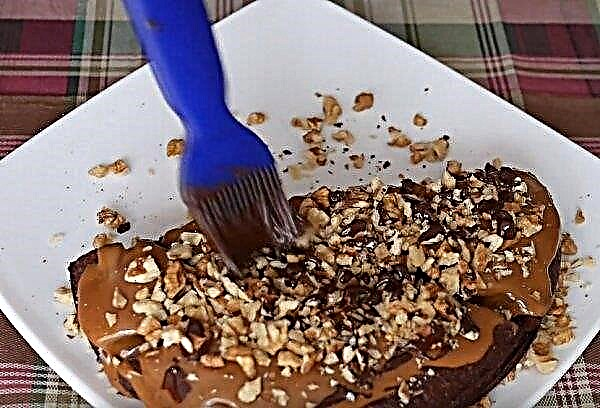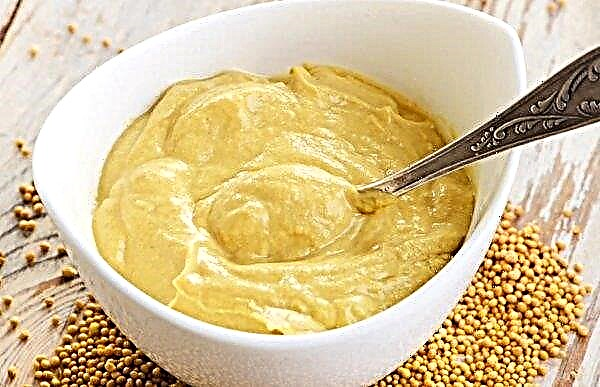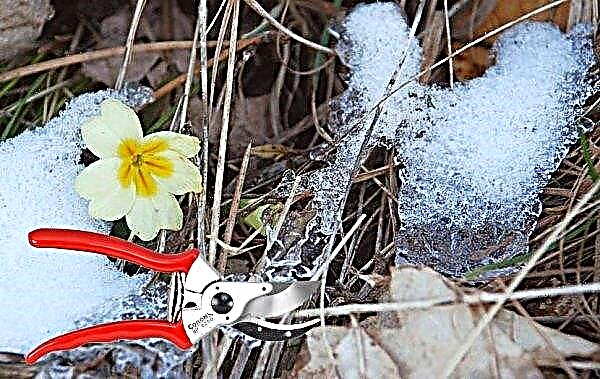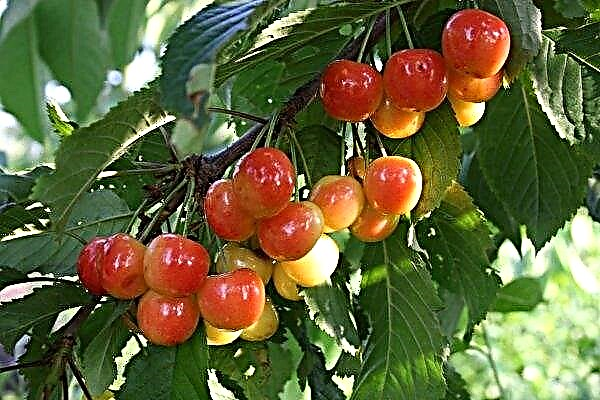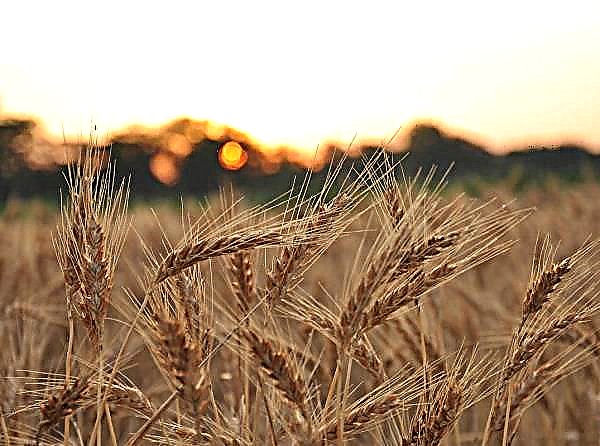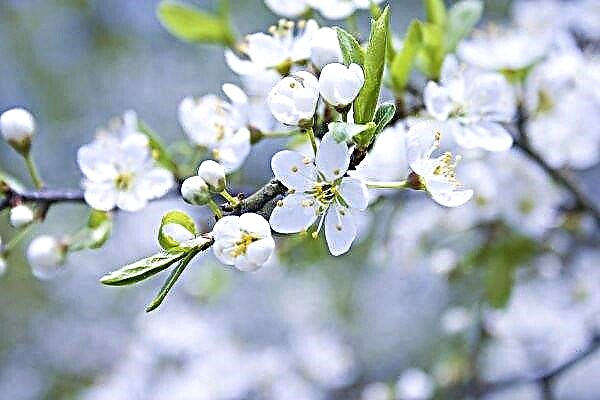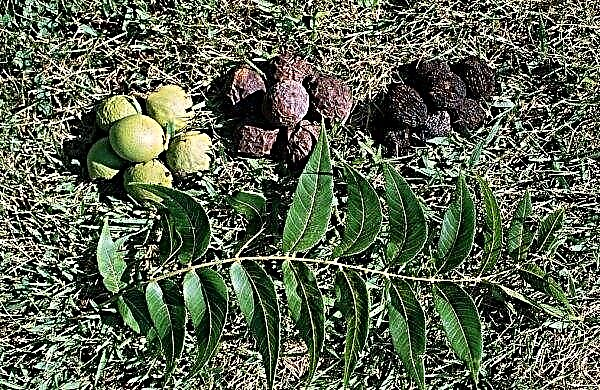Medinilla - a plant native to tropical forests, which is rarely found in the home collection of amateur gardeners. Due to the fact that medinilla likes to grow at a certain temperature and high humidity, it is more common in greenhouses and botanical gardens. However, with due diligence and compliance with some requirements, this exotic plant can be grown in an ordinary apartment - more on this later in the article.
Botanical description of the plant
In nature, there are species of medinilla in the form of small bushes, sometimes trees or vines. All of them belong to the Melastomov family and have about 400 species. They grow mainly on the soil, but can also be epiphytes. Range - tropical Africa, Asia, Pacific islands. The stems of the plant are dense, have a greenish-brown color. They contain large, whole leaves, mostly opposite, but there are species with a whorled (three leaves depart from each stem) foliage arrangement. The leaf plate has a bright central vein.
Did you know? The age of the tree is determined by the annual rings, but it turns out that it is impossible to do with tropical trees. Due to the fact that the tropics do not have distinct periods of cooling and drought, most trees do not have visible tree rings.
The medinilla inflorescence is almost always pink, drooping, consists of several flowers in the form of tubes or bells - their number is usually from 4 to 6. Each flower has a larger bract, but it falls off immediately after flowering begins. You can see the buds of pink, purple and salmon flowers. If pollination was successful, then small-sized fruits appear in the form of an elongated berry. Oblong seeds can be found inside each berry.
For convenience, all information about the appearance of the plant in question is given in the table:
| Root system | Fibrous, highly branched |
| Stem | Straight, tight |
| Leaf shape | Oval |
| Leaf color | Dark green |
| Flower shape | Tubular or bell-shaped |
| Flower color | Pink, white, purple |
| Fruit shape | Oblong |
| Fruit color | The black |
| Fruit flavor | There is no data |
Main types
Despite the variety of medinilla species, a limited number of them can be grown in houses.
Get to know them:
- Medinilla is magnificent (magnifica). This species is the most common among gardeners. In the wild, such a plant can be found in the Philippines in the form of a bush about 1.5 m in height. It has inflorescences with pink flowers of a reddish hue, and the bracts are pale pink. Taking into account the color, this species has excellent decorativeness. Breeders have created more than ten varieties of magnifica medinilla - Dolce Vita, Zhador Vita, Trezor, Bello, etc. They are the most popular, although quite picky about leaving.

- Medinilla veins. This species has another widespread name - veinous melastoma, originally from Malaysia. It belongs to semi-epiphytic plants, its shoots have a bristly surface, the leaves are small, oval in shape, but pointed at the ends. Inflorescences of the melastoma in the form of an umbrella, saturated flesh color.

- Medinilla Cumming. Homeland - Philippines, grows in the form of a small shrub and has large, slightly concave leaves with shine. Flowering time - spring, inflorescences racemose, pink.

- Medinilla Javanica. A fairly popular view among gardeners. It differs in that it is less whimsical to care for. It is a small shrub with bright purple flowers. This species has no bracts, so it is not as decorative as the others.

Comfortable conditions for growing a house
The tropical flower in question is very moody, so it is very important to create such conditions of detention that surround it in nature.
Lighting
For a comfortable flower life you need a long daylight: the light should be bright, but diffused. In winter, for this purpose, you can place the plant near a window that faces south. It is not scary if direct sunlight will fall on the medinilla: in winter they are not scorching. If necessary, use artificial lighting. But in the summer it is imperative to protect the flower from the bright midday sun.
Did you know? Rainforests occupy only 2% of the earth’s surface, but they are present on all continents except Antarctica and are the natural habitat for 50% of the Earth’s flora and fauna.
Ventilation
When ventilating the room where this tropical flower is located, you need to be careful: he does not like sudden changes in air temperature and draft, so you should not keep it near the heater or wide open window.
Temperature
The optimal indoor temperature should be from +20 to + 25 ° C. In the cold period, cooling is permissible up to + 16 ° C, but not lower. If the air is at a lower temperature, this can trigger the death of the flower. Temperature indicators above + 25 ° С are also not very comfortable for medinilla - in this case, an increase in air humidity is necessary.
Air humidity
For complete comfort, the plant described requires a humidity of more than 75%: in an ordinary house, such indicators are not easy to maintain. It is recommended to place containers next to the medinilla with pebbles or expanded clay, which are moistened with plenty. It is also necessary to constantly, several times during the day, spray with clean water, which is well settled. If possible, you can purchase air humidifiers. Such devices greatly facilitate the task of maintaining constant humidity at the right level, especially in the heating season.
Important! Hard water will result in loss of decorative effect and medinilla disease.
Home Care
In addition to creating comfortable climatic conditions, medinilla requires good constant care. Consider what it is.
Watering
The frequency of watering a plant depends on the time of year. The flowering period falls in the spring, therefore, at the end of winter, flower buds are laid: starting from this period, the flower is watered often and abundantly, the soil in the pot should always be slightly moist. When half of the flowering period passes, watering is gradually reduced - the soil should dry in depth to 3 cm. At the beginning of winter, when the dormant period begins, watering should be very rare, you can even allow slight wilting of the leaves. Water for irrigation should be at room temperature and must be purified from chlorine and lime.
When half of the flowering period passes, watering is gradually reduced - the soil should dry in depth to 3 cm. At the beginning of winter, when the dormant period begins, watering should be very rare, you can even allow slight wilting of the leaves. Water for irrigation should be at room temperature and must be purified from chlorine and lime.
Top dressing
This flower is quite demanding on the nutritional value of the soil in which it grows. Fertilizers are needed not only for magnificent flowering, but also for the normal development of the plant. It is necessary to replenish the required level of nutrients throughout the entire phase of active development, in this case it is spring, summer and autumn. Experienced growers are advised to apply fertilizing every week, but use reduced doses of fertilizers. Note that medinilla can be fertilized with mixtures for rhododendrons, as well as using universal dressings for flowering plants.
Pruning
There are several nuances in cropping medinilla:
- the procedure is performed after full flowering;
- at the same time as pruning, which is done to form the crown, a mandatory transplant should be performed;
- if a transplant is not planned, then cut only the peduncles, otherwise you risk losing the plant.

Transfer
Medinilla transplantation is performed according to the following rules:
- the procedure is required immediately after purchase;
- for a young plant is carried out every year;
- after two years of age - after 2-3 years.
The transplant process is as follows:
- pick a shallow ceramic pot, since the root system of this plant is small and is located not far from the soil surface;
- Be sure to put large drainage at the bottom of the tank;
- prepare an earthen mixture that contains turf and leaf soil, peat, sand, humus from the leaves, you can add a little pine bark;
- remove the plant from the old tank, partially free the roots from an earthen coma;
- do not forget to check the roots and if necessary remove damaged ones;
- plant the flower in new soil, not deeply digging;
- water abundantly.
Breeding
Medinilla can be propagated by cuttings and seeds: we will consider each method separately.
Cuttings
First of all, cut the cuttings from the already lignified branches - each of them should have 2-3 buds. Then dip the slice into ground activated carbon. Drop them in a sand container. Next, the cuttings are abundantly watered and covered to create a microclimate. For this purpose, you can use glass, polyethylene, cling film. For rooting, it is necessary to maintain a temperature of +25 to + 30 ° C and provide a sufficient amount of light (up to 14 hours). After about a month, the cuttings will take root. Then, rooted cuttings are planted in small pots (about 9 cm in diameter), and soil for adult plants is used. For the stem to begin to branch, you need to pinch it once as it grows (stage 4-5 internodes).
For rooting, it is necessary to maintain a temperature of +25 to + 30 ° C and provide a sufficient amount of light (up to 14 hours). After about a month, the cuttings will take root. Then, rooted cuttings are planted in small pots (about 9 cm in diameter), and soil for adult plants is used. For the stem to begin to branch, you need to pinch it once as it grows (stage 4-5 internodes).
Seed cultivation
In this case, you need to collect seeds from an adult plant yourself or purchase in a specialized store. For sowing seeds, prepare flat small pots and a mixture of soil, where there is sheet soil and sand in equal amounts. The seeds are sown in February or March, after which they are watered and covered with a transparent film, put in a warm place.
Important! Seeds on a medinilla bush ripen in 2–3 weeks after completion of the flowering process.
Shoots usually appear within 3 weeks, after which the sprouts need light for 12 hours. Dive into individual pots is done when there are 2 real leaves. The recommended pot size is 7 cm; the soil mixture is used for adult plants. Then in June, the sprouts are placed in larger pots by transshipment and looked after as usual.
Growing difficulties
When growing medinilla as an indoor flower, the following problems are possible:
- the leaves become smaller and curl - the humidity is insufficient. To improve the situation, it is necessary to carry out spraying more often, and also to place a wide tank filled with water next to the plant;
- dumping leaves, buds or buds - Too often moving the flower from place to place or insufficient moisture. In this case, you need to leave the flower alone and increase the humidity;
- the plant does not give flowers - improper care. Air humidity, lighting, temperature should be normalized;
- brown or black spots are observed on the stem - evidence of the presence of Botritis fungal disease. For treatment, remove the damaged shoot and treat with an antifungal agent;
- worms - The main pests that can appear in winter. You can get rid of them by rubbing the leaves with alcohol using a cotton swab;
- perhaps defeat by pests such as the red tick and scale insect, with which you can successfully fight with a soap solution or alcohol.
 Medinilla is a wonderful tropical plant that, if desired, can be grown at home, knowing how to do it and what difficulties may arise.
Medinilla is a wonderful tropical plant that, if desired, can be grown at home, knowing how to do it and what difficulties may arise.





